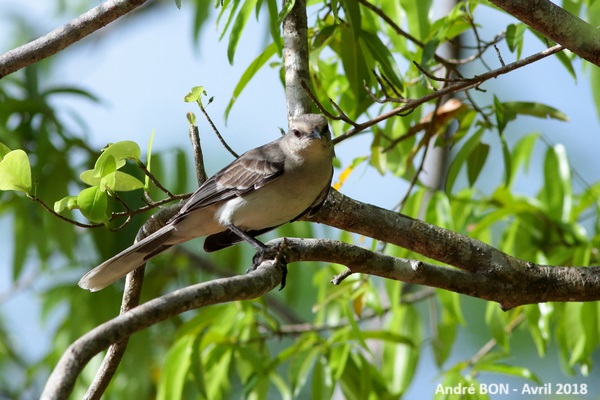

| Tropical Mockingbird (Mimus gilvus (Vieillot, 1808)) |


|
|
Scientific name: Mimus gilvus (Vieillot, 1808) Common name: Tropical Mockingbird French name: Moqueur des savanes, Grive moqueuse. Order: Passeriformes Family: Mimidae Size: Body size: 23 to 25.5 cm; Weight: 50 to 55 g. Habitat: Open and dry areas, savannah, bushes, cultivated areas, gardens. Food: Seeds, berries, and small insects often picked up or captured on the ground. Nesting: The nest is a rather wide cup built low in a thorny shrub or in a thick bush. There may be several clutches of 2 to 3 eggs. The nest is sometimes parasitized by the Shiny Cowbird (Molothrus bonariensis). Migration: Sedentary. Geographic area: Central America from southern Mexico, northern and eastern South America, West Indies. |
The Tropical Mockingbird has long legs and a long tail. The plumage is medium grey above, from crown to back and rump. The wings are blackish-grey with two white wingbars. The tail is blackish with broad white tips on the sides. The underside is whitish. The face is whitish with a light greyish line from the forehead to behind the eye, above the dark grey lores. The blackish bill is slightly down-curved. The legs are blackish. There are 10 subspecies which differ in size, length of legs and tail as well as intensity of plumage colours among others. |
| [To know more about the Tropical Mockingbird] [Next picture] [Top] |

|
The Tropical Mockingbird is a rather common bird in Martinique. This one was photographed at the beach of Grande Anse d'Arlet. |
| [To know more about the Tropical Mockingbird] [Previous picture] [Top] |

|
The Caravelle peninsula is home to the White-breasted Thrasher (Ramphocinclus brachyurus), an endemic and rare species of Martinique. I may have seen it but my photos are not enough to confirm it. Finally it was the Tropical Mockingbird, a much more common bird, which I met a little further on. |